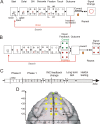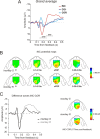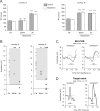Frontal feedback-related potentials in nonhuman primates: modulation during learning and under haloperidol
- PMID: 20016082
- PMCID: PMC6666180
- DOI: 10.1523/JNEUROSCI.4943-09.2009
Frontal feedback-related potentials in nonhuman primates: modulation during learning and under haloperidol
Abstract
Feedback monitoring and adaptation of performance involve a medial reward system including medial frontal cortical areas, the medial striatum, and the dopaminergic system. A considerable amount of data has been obtained on frontal surface feedback-related potentials (FRPs) in humans and on the correlate of outcome monitoring with single unit activity in monkeys. However, work is needed to bridge knowledge obtained in the two species. The present work describes FRPs in monkeys, using chronic recordings, during a trial and error task. We show that frontal FRPs are differentially sensitive to successes and failures and can be observed over long-term periods. In addition, using the dopamine antagonist haloperidol we observe a selective effect on FRP amplitude that is absent for pure sensory-related potentials. These results describe frontal dopaminergic-dependent FRPs in monkeys and corroborate a human-monkey homology for performance monitoring signals.
Figures





Comment in
-
Eye movement artifact may account for putative frontal feedback-related potentials in nonhuman primates.J Neurosci. 2010 Mar 24;30(12):4187-9. doi: 10.1523/JNEUROSCI.0449-10.2010. J Neurosci. 2010. PMID: 20335453 Free PMC article. No abstract available.
Similar articles
-
Eye movement artifact may account for putative frontal feedback-related potentials in nonhuman primates.J Neurosci. 2010 Mar 24;30(12):4187-9. doi: 10.1523/JNEUROSCI.0449-10.2010. J Neurosci. 2010. PMID: 20335453 Free PMC article. No abstract available.
-
Event-related potentials reflect impaired temporal interval learning following haloperidol administration.Psychopharmacology (Berl). 2017 Sep;234(17):2545-2562. doi: 10.1007/s00213-017-4645-2. Epub 2017 Jun 10. Psychopharmacology (Berl). 2017. PMID: 28601965 Clinical Trial.
-
Causal control of medial-frontal cortex governs electrophysiological and behavioral indices of performance monitoring and learning.J Neurosci. 2014 Mar 19;34(12):4214-27. doi: 10.1523/JNEUROSCI.5421-13.2014. J Neurosci. 2014. PMID: 24647942 Free PMC article.
-
Potentials evoked in human and monkey cerebral cortex by stimulation of the median nerve. A review of scalp and intracranial recordings.Brain. 1991 Dec;114 ( Pt 6):2465-503. doi: 10.1093/brain/114.6.2465. Brain. 1991. PMID: 1782527 Review.
-
Reinforcement-related brain potentials from medial frontal cortex: origins and functional significance.Neurosci Biobehav Rev. 2004 Jul;28(4):441-8. doi: 10.1016/j.neubiorev.2004.05.003. Neurosci Biobehav Rev. 2004. PMID: 15289008 Review.
Cited by
-
Performance monitoring local field potentials in the medial frontal cortex of primates: supplementary eye field.J Neurophysiol. 2010 Sep;104(3):1523-37. doi: 10.1152/jn.01001.2009. Epub 2010 Jul 21. J Neurophysiol. 2010. PMID: 20660423 Free PMC article.
-
Electrophysiology as a theoretical and methodological hub for the neural sciences.Psychophysiology. 2019 Feb;56(2):e13314. doi: 10.1111/psyp.13314. Epub 2018 Dec 16. Psychophysiology. 2019. PMID: 30556196 Free PMC article. Review.
-
Eye movement artifact may account for putative frontal feedback-related potentials in nonhuman primates.J Neurosci. 2010 Mar 24;30(12):4187-9. doi: 10.1523/JNEUROSCI.0449-10.2010. J Neurosci. 2010. PMID: 20335453 Free PMC article. No abstract available.
-
Choice modulates the neural dynamics of prediction error processing during rewarded learning.Neuroimage. 2011 Jan 15;54(2):1385-94. doi: 10.1016/j.neuroimage.2010.09.051. Epub 2010 Sep 25. Neuroimage. 2011. PMID: 20884356 Free PMC article.
-
Early presymptomatic and long-term changes of rest activity cycles and cognitive behavior in a MPTP-monkey model of Parkinson's disease.PLoS One. 2011;6(8):e23952. doi: 10.1371/journal.pone.0023952. Epub 2011 Aug 24. PLoS One. 2011. PMID: 21887350 Free PMC article.
References
-
- Botvinick MM, Cohen JD, Carter CS. Conflict monitoring and anterior cingulate cortex: an update. Trends Cogn Sci. 2004;8:539–546. - PubMed
-
- Brooks VB. How does the limbic system assist motor learning? a limbic comparator hypothesis. Brain Behav Evol. 1986;29:29–53. - PubMed
-
- Castner SA, Williams GV, Goldman-Rakic PS. Reversal of antipsychotic-induced working memory deficits by short-term dopamine D1 receptor stimulation. Science. 2000;287:2020–2022. - PubMed
-
- Coffin VL, Latranyi MB, Chipkin RE. Acute extrapyramidal syndrome in Cebus monkeys: development mediated by dopamine D2 but not D1 receptors. J Pharmacol Exp Ther. 1989;249:769–774. - PubMed
Publication types
MeSH terms
Substances
LinkOut - more resources
Full Text Sources
Miscellaneous
